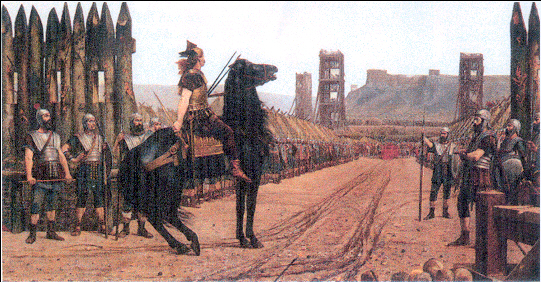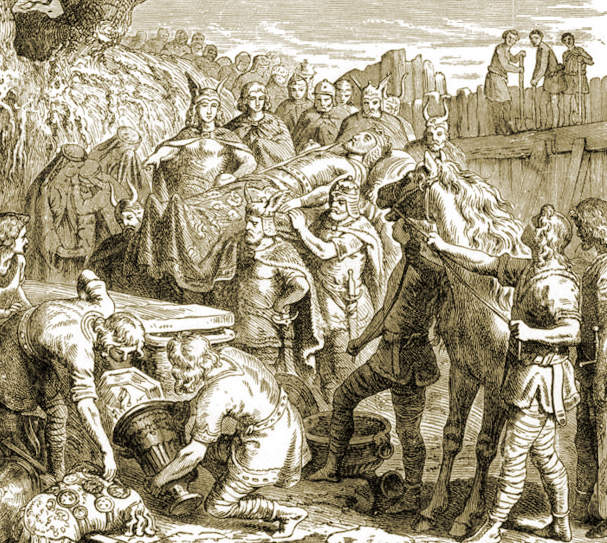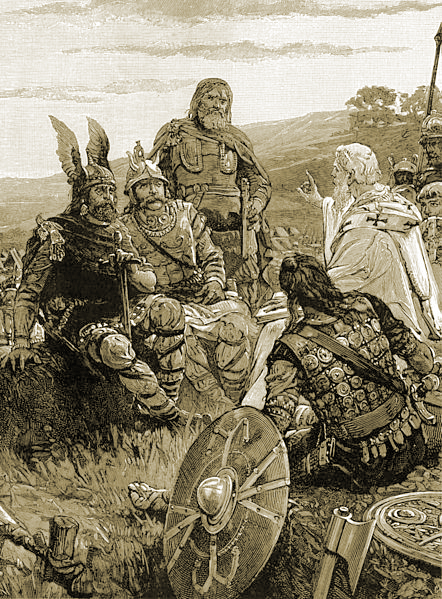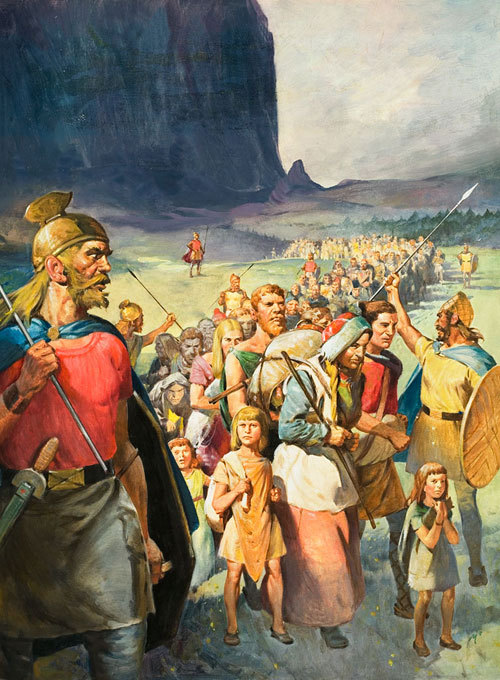The following is my abridgement of chapter 14 of William Pierce’s history of the white race, Who We Are:
One of the Principal Indo-European Peoples Who Founded Europe
Celts Were Fierce Warriors, Master Craftsmen
Roman Conquest Drowned Celtic Europe in Blood
In the last few installments we have dealt with those Indo-European peoples which, after leaving their homeland north of the Black Sea and the Caspian Sea, between the Urals and the Dnieper, invaded regions of the world heavily populated by alien races. Some—the Aryans, Kassites, Mitanni, Hittites, Phrygians, and Philistines—went into the Middle East, conquered the natives, and then gradually sank down into them through racial mixing over the course of millennia.
Others—the Achaeans, Dorians and Latins—went southwest, into the Greek and Italian peninsulas, conquered the aboriginal Mediterraneans already there, and founded the great civilizations of Classical antiquity. Although the racial differences between them and the natives were not as great as for those who went into the Middle East, mixing took its toll of these Indo-Europeans as well, and they gradually lost their original racial character.
Four Indo-European Peoples. The Indo-Europeans who invaded [the north] of Europe were able to remain racially pure, to a much greater extent than their cousins who invaded the more southerly and easterly regions, even to the present day. They established, in effect, a new Indo-European heartland in northern Europe. We shall look at four great divisions of these Indo-European peoples: the Celts, Germans, Balts, and Slavs.
These divisions are distinguished one from another by language, geography, and time of appearance on the stage of world history, as well as by their subsequent fates. But one salient fact should be kept in mind throughout the individual treatments of the Celts, Germans, Balts, and Slavs which follow: they are all branches from the same trunk.
Originally, Celt, German, Balt, and Slav were indistinguishably Nordic. The Celts were the first group to make an impact on the Classical world, and so we will deal with them first. (The “C” may be pronounced either with an “s” sound, the result of French influence, or with a “k” sound. The latter was the original pronunciation.) The reason the Celts interacted with the Greeks and Romans before the other groups did is that their wanderings took them farthest south. The Roman conquest of southeastern Europe, Gaul, and Britain destroyed the greater part of Celtic culture, as well as doing an enormous amount of racial damage.
But the Celts themselves, as much as anyone else, were responsible for the decline of their racial fortunes. They settled in regions of Europe which, although not so heavily Mediterraneanized as Greece and Italy, were much more so than the German, Baltic, and Slavic areas. And, as has so often been the case with the Indo-Europeans, for the most part they did not force the indigenous populations out of the areas they conquered, but made subjects of them instead.
Thus, many people who think of themselves as “Celts” today are actually more Mediterranean than Celtic. And others, with Latin, Germanic, or Slavic names, are actually of nearly unmixed Celtic descent.
In this installment we will look at the origins of the Celts and at their interaction with the Romans.
The early Celts were not literate, and we are, therefore, dependent on Classical authors for much of what we know about Celtic mores, lifestyles, and behavior, as well as the physical appearance of the Celts themselves. The fourth-century Byzantine writer, Ammianus Marcellinus, drawing on reports from the first century B.C., tells us that the Celts (or Gauls, as the Romans called them) were fastidious, fair, and fierce:
The Gauls are all exceedingly careful of cleanliness and neatness, nor in all the country could any man or woman, however poor, be seen either dirty or ragged.
Nearly all are of a lofty stature, fair and of ruddy complexion: terrible from the sternness of their eyes, very quarrelsome, and of great pride and insolence. A whole troop of foreigners would not be able to withstand a single Gaul if he called his wife to his assistance, who is usually very strong and with blue eyes.
All the Classical writers agree in their descriptions of the Celts as being tall, light-eyed, and with blond or red hair, which they wore long. Flowing, abundant mustaches seem to have been a Celtic national trait.
And the favorite national pastime seems to have been fighting. Born to the saddle and bred to arms, the Celts were a warlike race, always ready for a brawl. Excellent horsemen and swordsmen, they were heartily feared by all their enemies.
Perhaps we should not be surprised that these equestrian warriors invented chain-link armor and iron horseshoes and were the first to learn how to make seamless iron tires for wagons and war chariots. But the Celts were also the inventors of soap, which they introduced to the relatively unwashed Greeks and Romans. Their inventive genius also manifested itself in the numerous iron woodworking tools and agricultural implements which they developed. They did not build castles, as such, but depended instead on strategically located hilltops, fortified with earthworks and palisades, as places of retreat in wartime.
Gradually these hill forts, or oppida (as the Romans called them), gained permanent inhabitants and enough amenities so that they could be considered towns. They became the sites of regular fairs and festivals, and centers of trade as well as defense.
Celtic society, following the customary Indo-European pattern, was hierarchical. At the top was a fighting and hunting aristocracy, always purely Celtic. At the bottom were the small farmers, the servants, and the petty craftsmen. The racial composition of this class varied from purely Celtic to mostly Mediterranean, depending on the region.
Relations between the sexes were open and natural, and—in contrast to the norm for Mediterranean societies—Celtic women were allowed a great deal of freedom.
When the wife of Sulpicius Severus, a Romanized fourth-century historian, reproached the wife of a Celtic chieftain for the wanton ways of Celtic women, the Celtic woman replied: “We fulfill the demands of nature in a much better way than do you Roman women: for we consort openly with the best men, whereas you let yourselves be debauched in secret by the vilest.” In fourth-century Rome, of course, virtually all the wealth was in the hands of “the vilest” men: Jews, Syrians, and other Oriental immigrants who dominated commerce and constituted the nouveaux riches.
The ancestors of the Celts brought the solar religion of their Indo-European homeland with them to the areas they invaded; three-armed and four-armed swastikas, as solar symbols, are an omnipresent element in Celtic art, as is the four-spoked sun wheel. One of the most widely revered Celtic gods, Lug (or Lugh), had many of the attributes of the Germanic Wotan, and one of his designations, Longhanded Lug, referred to his role as a solar deity, whose life-giving force reached everywhere.
By the time of the Roman conquest, however, many extraneous elements had become inseparably blended into Celtic religion. The druids practiced not only solar rites, but some rather dark and nasty ones of Mediterranean origin as well.
Many later writers have not been as careful as Caesar was and tend to lump all Celtic-speaking populations together as “Gauls,” while sharply distinguishing them from the Germans. As a matter of fact, there was a much greater affinity between the Celts and the Germans, despite the language difference, than there was between the truly Celtic elements among the Gauls and the racially different but Celtic-speaking Mediterranean and Celtiberian elements.
In the British Isles the racial effects of the fifth-century B.C. Celtic invasions varied. In some areas indigenous Nordic populations were reinforced, and in others indigenous Mediterranean or mixed populations diluted the fresh Nordic wave.
Brennus Sacks Rome. Around 400 B.C. Celts invaded northern Italy in strength, establishing a permanent presence in the Po valley, between the Alps and the Apennines. They pushed out the resident Etruscans and Ligurians, founded the city of Milan, and began exploring possibilities for further expansion south of the Apennines.
In 390 B.C. a Celtic army under their chieftain Brennus defeated the Roman army and occupied Rome. The Celts were not prepared to stay, however, and upon payment of an enormous ransom in gold by the Romans they withdrew again to northern Italy.
In the following centuries there were repeated clashes between adventurous Celts and the people of the Classical civilizations to the south. In the third century B.C. a Celtic army ravaged Macedonia and struck deep into Greece, while another group of Celts, the Galatae, invaded central Asia Minor. Three centuries later the latter were still in place; they were the Galatians of the New Testament.
[Roman revenge.] Celtic bands continued to whip Roman armies, even to the end of the second century B.C., but then Roman military organization and discipline turned the tide. The first century B.C. was a time of unmitigated disaster for the Celts. Caesar’s conquest of Gaul was savage and bloody, with whole tribes, including women and children, being slaughtered by the Romans.
By the autumn of 54 B.C, Caesar had subdued Gaul, having destroyed 800 towns and villages and killed or enslaved more than three million Celts. And behind his armies came a horde of Roman-Jewish merchants and speculators, to batten on what was left of Gallic trade, industry, and agriculture like a swarm of locusts. Hundreds of thousands of blond, blue-eyed Celtic girls were marched south in chains, to be pawed over by greasy, Semitic flesh-merchants in Rome’s slave markets before being shipped out to fill the bordellos of the Levant.
 Vercingetorix. Then began one, last, heroic effort by the Celts of Gaul to throw off the yoke of Rome, thereby regaining their honor and their freedom, and—whether consciously or not—reestablishing the superiority of Nordic mankind over the mongrel races of the south. The ancestors of the Romans had themselves established this superiority in centuries past, but by Caesar’s time Rome had sunk irretrievably into the quagmire of miscegenation and had become the enemy of the race which founded it.
Vercingetorix. Then began one, last, heroic effort by the Celts of Gaul to throw off the yoke of Rome, thereby regaining their honor and their freedom, and—whether consciously or not—reestablishing the superiority of Nordic mankind over the mongrel races of the south. The ancestors of the Romans had themselves established this superiority in centuries past, but by Caesar’s time Rome had sunk irretrievably into the quagmire of miscegenation and had become the enemy of the race which founded it.
The rebellion began with an attack by Ambiorix, king of the Celtic tribe of the Eburones, on a Roman fortress on the middle Moselle. It spread rapidly throughout most of northern and central Gaul. The Celts used guerrilla tactics against the Romans, ruthlessly burning their own villages and fields to deny the enemy food and then ambushing his vulnerable supply columns.
For two bloody years the uprising went on. Caesar surpassed his former cruelty and savagery in trying to put it down. When Celtic prisoners were taken, the Romans tortured them hideously before killing them. When the rebel town of Avaricum fell to Caesar’s legions, he ordered the massacre of its 40,000 inhabitants.
Meanwhile, a new leader of the Gallic Celts had come to the fore. He was Vercingetorix, king of the Arverni, the tribe which gave its name to France’s Auvergne region. His own name meant, in the Celtic tongue, “warrior king,” and he was well named.
Vercingetorix came closer than anyone else had to uniting the Celts. He was a charismatic leader, and his successes against the Romans, particularly at Gergovia, the principal town of the Arverni, roused the hopes of other Celtic peoples. Tribe after tribe joined his rebel confederation, and for a while it seemed as if Caesar might be driven from Gaul.
But unity was still too new an experience for the Celts, nor could all their valor make up for their lack of the long experience of iron discipline which the Roman legionaries enjoyed. Too impetuous, too individualistic, too prone to rush headlong in pursuit of a temporary advantage instead of subjecting themselves always to the cooler-headed direction of their leaders, the Celts soon dissipated their chances of liberating Gaul.
Finally, in the summer of 52 B.C., Caesar’s legions penned up Vercingetorix and 80,000 of his followers in the walled town of, Alesia, on the upper Teaches of the Seine. Although an army of a quarter-million Celts, from 41 tribes, eventually came to relieve besieged Alesia, Caesar had had time to construct massive defenses for his army. While the encircled Alesians starved, the Celts outside the Roman lines wasted their strength in futile assaults on Caesar’s fortifications.
Savage End. In a valiant, self-sacrificing effort to save his people from being annihilated, Vercingetorix rode out of Alesia, on a late September day, and surrendered himself to Caesar. Caesar sent the Celtic king to Rome in chains, kept him in a dungeon for six years, and then, during the former’s triumphal procession of 46 B.C., had him publicly strangled and beheaded in the Forum, to the wild cheers of the city’s degraded, mongrel populace.
After the disaster at Alesia, the confederation Vercingetorix had put together crumbled, and Caesar had little trouble in extinguishing the last Celtic resistance in Gaul. He used his tried-and-true methods, which included chopping the hands off all the Celtic prisoners he took after one town, Uxellodunum, commanded by a loyal adjutant of Vercingetorix, surrendered to him.
Decadent Rome did not long enjoy dominion of the Celtic lands, however, because another Indo-European people, the Germans, soon replaced the Latins as the masters of Europe.








